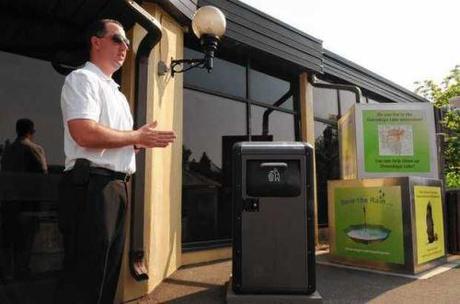
Your tax dollars at work…
Syracuse.com: (Syracuse, NY) – There is a $4,000 trash can at the zoo in Syracuse. There’s another one near a downtown parking lot outside the OnCenter. Taxpayers bought them with federal stimulus money.
Onondaga County’s Deputy County Executive Matt Millea would like to use state money to buy as many as 300 more and put them all over Syracuse. That could cost more than $1 million.
Millea is proud of the “Big Belly” solar trash cans – even though each one costs about 21 times more than a traditional municipal can.
Each Big Belly is powered by solar panels that operate a compactor that can crush 150 gallons of trash so it fits in one can. That’s five times more than a typical trash can holds, according to the manufacturer.
That’s not all. It also has a wireless connection that beams an alert to staff in the mothership office when the trash can is full and ready to be emptied.
Other cities that installed the Big Belly trash cans say they are more efficient and save time and money because there are fewer cans for crews to visit and they know when they are full.
Onondaga County bought two $4,000 Big Belly models for demonstration. To find the one at the zoo, pass the new octopus display, go out the doors and look to your left. Meet Big Belly, on ordinary-looking black, enclosed steel and plastic trash can with solar panels on top.
The county used $8,520 from the U.S. Department of Energy to buy two trash cans in 2012, according to the invoice on file in the county comptroller’s office.
The county and the city are about to write a grant application to the New York State Energy Research and Development Authority to buy as many as 300 more, Millea said.
It’s all part of the county’s “floatable control program”, which is intended to help clean up Onondaga Lake, he said.
If people drop bottles and other trash in the Big Belly instead of throwing it on the ground, the trash is less likely to wind up in the streams and tributaries that flow into Onondaga Lake, Millea said.
In Onondaga County, the storm and sewage pipes are combined. The county government, which owns the pipes, is under a court order to stop storm water and its floatables from overflowing into the lake.
The first “flush” after a big storm often sweeps up the litter people have tossed into the streets into the storm drains. One way the county filters out floatable trash is with a $4.9 million system of underground nets at Franklin Square. Millea said the New York Department of Environmental Conservation could order the county to do more, such as build another expensive, similar-sized facility.
Instead, he hopes hundreds of Big Bellies could eat the trash.
There is nothing about the Big Belly experience that would compel people to use it any more than an ordinary trash can, which would cost about $200 through current state contracts.
But Andrew Maxwell, Syracuse’s director of planning and sustainability, said the energy around flashy new machines could encourage people to think about doing the right thing.
Also, Syracuse does not have a city-wide system of public bins for recyclables, and this could be a way to introduce some, he said.
“I think taking an initiative like this would hopefully call more attention to the problem of litter in our community,” Maxwell said. “It’s pretty cool stuff. We want to learn from what other cities have done and I’m certainly interested in learning more myself about what the county’s experience is with the two units.”
Big Belly Solar is a Massachusetts company, started in 2003 by Jim Poss. They are made in Kentucky and Vermont, according to Matt Volpi, the company’s marketing director.
A search of stimulus funding data on the government’s website Recovery.gov shows other cities reported using federal funds to buy Big Belly trash cans. Atlantic City told the federal government that it was using stimulus money to put them on the boardwalk. Albany said it was using the money for 93 Big Belly trash cans. Albany reported the stimulus grant made 1.5 jobs for consultants.
Stimulus funding, more formally known as the American Recovery and Reinvestment Act of 2009, was intended to make jobs. The whole idea of installing Big Bellies is to reduce the workload for municipalities. But stimulus funding did give a boost to Big Belly Solar.
The company employs about 50 people and hires manufacturers on contract to make the product, Volpi said.
“The stimulus definitely helped. We knew that we had something that was a good idea and that people were interested in, but when you’re selling into the municipal government sector, they don’t necessarily have a lot of extra money,” Volpi said. “Being able to apply for those dollars allowed people to make purchases and accelerate deployments faster.”
Onondaga County hopes to pay for more solar-powered trash cans with some of the $100 million Gov. Andrew Cuomo is giving away in competitive Cleaner, Greener Communities grants. The state money comes from the sale of extra greenhouse gas emission allowances to power generators. It does not come from tax revenue.
This is an Onondaga County project, but Millea said Syracuse officials are on board. “As long as they’re not going to have to buy them,” Millea said.
How are these things going to work all year long? Syracuse is hardly as sunny as Los Angeles.
Your tax dollars at work!
DCG

